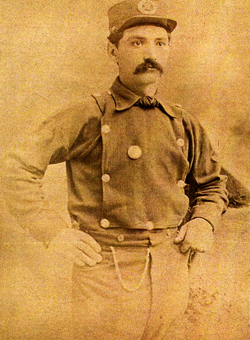Christ Hoell, 1849–1877
|
Christ Hoell was born on 7 December 1849 in Hesse (Elberfeld) Germany. He married Wilhelmina Dietermann and they began a family in 1869 with the birth of their daughter, Emilie. Their second child, Alexander, died shortly after birth. In addition to being a stone mason, Hoell was a member of the Elberfeld Volunteer Fire Department for seven years. While there, he learned and used the pompier, which was a German fire ladder developed around 1828 by a Mr. Behl and introduced in Elberfeld around 1864. Christ Hoell immigrated to St. Louis in 1873 at age twenty-seven with his wife, age twenty-eight, daughter, Emelie, age four, and son, Oscar, ten months. The Hoell family continued to grow with the births of four additional children: Alexander, Oswald, Ottilie, and Lydia. After the Brooklyn theater in New York burned in 1876 and then the Southern Hotel fire in downtown St. Louis on 11 April 1877, Hoell wrote a letter to the Westliche Post newspaper suggesting the creation of a pompier corps in the St. Louis fire department to address fires in high rise buildings, and he offered his services to instruct. On 19 June 1877, a volunteer corps led by Hoell, gave a public display of the pompier drill and apparatus. As a result of this exhibition, the pompier corps was organized by H. Clay Sexton, then captain of the department. Following a fire on 10 August 1887, walls of the ruins of Bishop & Spear’s peanut warehouse at 510 and 512 North Second Street fell and carried with them a portion of J. Alkire & Co’s wholesale grocery house, at numbers 514 and 516. In the ruins were buried a number of firemen, three of whom were taken out dead. Christ Hoell was among them, having been killed when an iron beam fell and crushed his skull. On 11 August 1877, the funeral service for fire fighters Hoell, McKernan, and McDonald was held at Engine House 23. The interior of the engine house, as well as the exterior, was heavily draped, the long festoons of white and black descending from the hooks to which the apparatus was fastened. Under these swinging lines of crepe, the immense crowds poured past. A little after three, the procession formed as follows:
The procession moved out Washington Ave. to Fifth to Olive to Seventh to Pine, and then to Jefferson Avenue, where the procession divided, half going with McDonald and McKernan to Calvary Cemetery and the other half to St. Matthew’s Cemetery on Bates and Morganford, where Captain Hoell was buried. He was just forty years old. Submitted by Gail A. Holzhausen © 2020, St. Louis Genealogical Society |
 Christ Hoell Photo in the collection of Gail Holzhausen Used with permission |
Return to St. Louis City/County Biographies.
Last Modified: 07-Dec-2021 09:41